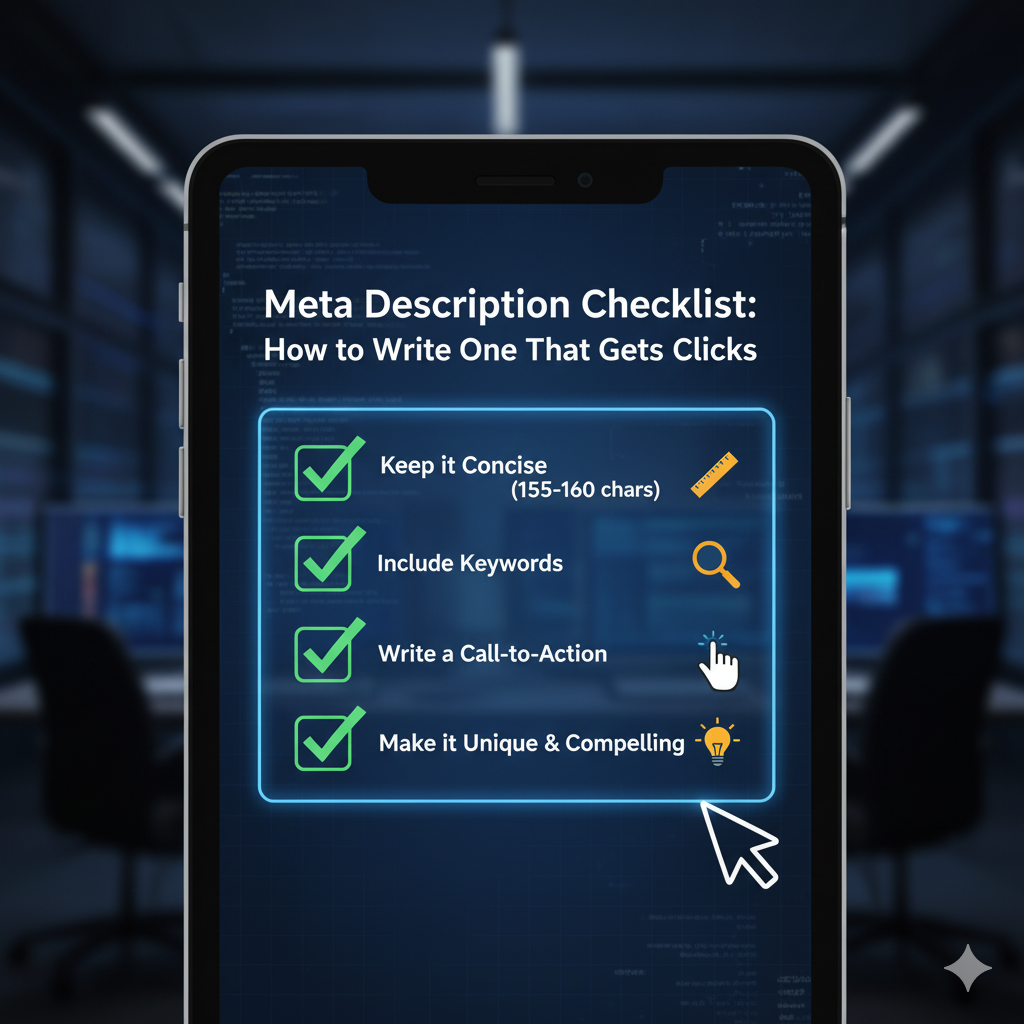
Meta Description Checklist: How to Write One That Gets Clicks
A meta description may be small, typically 150–160 characters—but it has a big impact on your website’s performance in search results. A well-written meta description doesn’t just improve SEO; it entices users to click your link over competitors’ listings.
This guide provides a practical meta description checklist to help you write descriptions that drive clicks and improve your search visibility.
What is a Meta Description?
A meta description is an HTML attribute that summarizes the content of a web page. Search engines often display it under the page title in search results. While meta descriptions don’t directly affect rankings, they influence click-through rates (CTR)—an important SEO metric.
Example:
Title: “Best Budget Laptops for Students in 2025”
Meta Description: “Discover the top affordable laptops for students in 2025. Compare features, prices, and performance to find your perfect laptop.”
A compelling meta description encourages searchers to click your page instead of scrolling past it.
Why Meta Descriptions Matter
Increase Click-Through Rate
A persuasive meta description grabs attention, conveys value, and motivates users to click. Higher CTR can indirectly boost SEO by signaling relevance to search engines.
Provide a Clear Summary
Meta descriptions help users quickly understand what your page is about, reducing bounce rates from mismatched expectations.
Enhance SERP Features
Well-crafted meta descriptions can complement rich snippets, FAQs, and structured data, improving visibility and trust.
Meta Description Checklist
Use this checklist to ensure your meta descriptions are optimized for clicks:
- Keep It Between 150–160 Characters
Longer descriptions may get truncated in search results, while very short ones don’t provide enough information. Aim for concise, informative text that fits within the visible limit. - Include the Target Keyword
Incorporate the primary keyword naturally to show relevance. Avoid keyword stuffing—focus on readability and user intent. - Highlight the Benefit or Value
Tell users why they should click. Focus on what problem your content solves or what value it provides.
Example: “Boost your productivity with 10 proven time-management tips for professionals.” - Use a Call-to-Action (CTA)
Encourage action with phrases like:
“Learn more”
“Get started today”
“Discover how”
CTAs create a sense of urgency and guide users toward the next step. - Match User Intent
Your meta description should reflect what the user expects to find on the page:
- Informational pages → promise answers or insights
- Product pages → highlight features, offers, or discounts
- Service pages → mention benefits, solutions, or unique selling points - Make It Unique
Each page should have a unique meta description to avoid duplicate content issues and improve user experience. Duplicate meta descriptions can confuse search engines and reduce CTR. - Write for Humans, Not Just Search Engines
Avoid over-optimization. Focus on clarity, tone, and appeal. A description that resonates with readers is more effective than one designed solely for SEO. - Test and Refine
Use tools like Google Search Console to monitor CTR. If certain pages have low CTR despite high impressions, rewrite the meta description to make it more compelling.
Example:
Keyword: “healthy meal plans”
Description: “Explore easy and nutritious healthy meal plans for busy adults. Save time and eat well every day.”
Additional Tips for Maximum Impact
- Use Numbers or Lists: E.g., “7 Tips to Improve Your SEO Today” draws attention.
- Add Power Words: Words like “proven,” “essential,” “free,” or “ultimate” encourage clicks.
- Address Pain Points: Speak directly to user needs or challenges.
- Keep It Consistent With Title and Content: Ensure your description accurately reflects the page content to avoid high bounce rates.
Final Thoughts
A meta description is a small element with big potential. By following this checklist—keeping it concise, including keywords, highlighting value, adding a CTA, and writing for humans—you can craft meta descriptions that not only improve CTR but also attract the right audience to your website.
Remember, meta descriptions are the first impression users get of your page in search results. A compelling, optimized description can make the difference between a click and a scroll past your content.
FAQs About Meta Descriptions
- Do meta descriptions affect Google rankings?
Not directly. However, higher CTR from effective meta descriptions can indirectly improve SEO performance. - Can Google rewrite my meta description?
Yes. Google sometimes generates its own snippet based on the user query if it believes a different text is more relevant. - How often should I update meta descriptions?
Review and update them whenever you refresh content, notice low CTR, or want to align with new search trends. - What’s the ideal length for mobile meta descriptions?
Keep descriptions between 140–160 characters to avoid truncation on both desktop and mobile devices. - Should product pages have unique meta descriptions?
Absolutely. Each product page should have a unique description highlighting key features, benefits, and offers to maximize clicks.